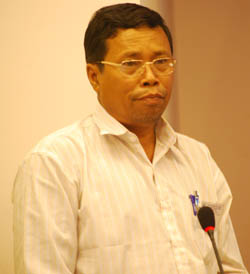Propagating indigenous fish species is
a profitable
business in Cambodia
A Takeo fish farmer tells his story

Mr Sieng Phan, fish farmer from Takeo
province
Photo: Lem Chamnap
| Rapid growth |
| Cambodia's aquaculture sector is projected to grow 50% to about 60,000 tonnes in 2009, according to a report delivered by Agriculture, Forestry and Fisheries Minister Chan Sarun. Speaking at the National Fish Day ceremony in Kep on July 1, the minister noted that Cambodia ranked seventh worldwide in terms of annual growth in aquaculture last year. Production totaled 40,000 tonnes in 2008, up from 35,000 tonnes in 2007. Dr Chan Sarun said the country now had 165 hatcheries capable of producing 60 million fry a year. In 2008, he said, Cambodia had about 50,000 fish farming households with about 50,000 earthen ponds and 3,800 floating cages. |
Apart from strong local demand, there are several other reasons for farming indigenous Mekong fish species. In some Cambodian provinces, for example, a lack of water supply means that farmers cannot rely entirely on growing rice for their income. For Sieng Phan, a farmer from Takeo province, raising indigenous fish species is an alternative to rice which helps diversify his source of income while sustaining the environment. "Propagation of indigenous fish is a profitable business," he told the annual meeting of the MRC Fisheries Programme in Siem Reap in June. Mr Sieng Phan has been farming fish for only six years. He started in 2003 with a 550m³ earthen pond. After receiving some basic training from the then Department of Fisheries, he removed all predators from the pond and prepared it with 40 kg of lime. He then fertilized it with 5kg of urea. 2.5 kg of diammonium phosphate and 200 kg of cow manure. When the water turned green after about a week, he stocked the pond with 1,250 fingerlings of four indigenous species (see Table 1). The fish were feed with cooked rice bran with broken rice, vegetable waste, duck weed and termites. After 10 months, Mr Sieng Phan harvested more than 90 kg of fish which he sold for almost $220, making a net profit of $150 which was used to build two more ponds.
Table 1: First pond (2003)
| Indigenous species | Ratio (%) | Yield (%) |
| Sutchi river catfish (trey pra) Pangasianodon hypophthalmus |
30 | 40 |
| Java carp (try chhpin) Barbonymus gonionotus |
30 | 38 |
| Hoeven's barb (trey priorlong) Leptobarbus hoevenii |
20 | 15 |
| Snakeskin gourami (trey kawnthor) Trichogaster pectoralus |
20 | 7 |
Under the supervision of MRC Fisheries Programme staff, Mr Sieng Phan started nursing 25 to 30-day-old fry from three of the four original species in 2005. The three species were Sutchi river catfish (Pangasianodon hypophthalmus), the Java barb (Barbonymus gonionotus) and Hoeven's carp (Leptobarbus hoevenii). When the fingerlings reached 5cm, he sold them to other fish farmers living in the same village for 80 riel (two cents) each. With production costs amounting to only 25 riel for each fingerling, he made a net profit of almost $200. During 2005, the farmer also received training in propagating these three species. He built a breeding system-comprising a spawning tank, two nursing tanks and an overhead tank-and dug 13 more ponds. He obtained 60 brooders (30 Java carp and 30 Hoeven's barb), transferred them to fertilised earthen ponds at a stocking density of one fish per 7m² and fed them a formula made from fish meal, rice bran, broken rice, soybean meal, rice germ and a vitamin premix. For breeding, he applied a single-injection technique for the hormone (Suprefact + motilium) that was introduced by the government fisheries research station at Chrang Chamres near Phnom Penh.
'The introduction of established alien species was expedient'
Table 2: Production and earnings (2003-2009)
Year |
Activities |
Inputs |
Outputs |
Net profit |
|
KHR |
USD |
||||
| 2003 | Grow-out | Fingerlings: 1,650 (4 species) Feed: cooked rice bran with broken rice, vegetable waste, duckweed and termites |
Harvest: 192 kg (4 species) |
594,000 | $149 |
| 2005 | Nursing | Fry: (3 species) Feed: home-made (20-25% protein) |
Fingerlings: (3 species) |
760,000 | $190 |
| 2005 | Breeding | Broodstock: 60 (2 species) Feed: formulated from fish meal, rice bran, broken rice, soybean meal, rice germ and vitamin premix (25% protein) Hormones: Suprefact + motilium |
Fingerlings: 112,000 (2 species) |
1,000,000 | $250 |
| 2007 | Breeding | Broodstock: 60 (2 species) Feed: formulated from fish meal, rice bran, broken rice, soybean meal, rice germ and vitamin premix (25% protein) Hormones: Suprefact + motilium |
Fingerlings: 130,000 (2 species) |
2,000,000 | $500 |
| 2008 | Breeding | Broodstock: 60 (2 species) Feed: formulated from fish meal, rice bran, broken rice, soybean meal, rice germ and vitamin premix (25% protein) Hormones: Suprefact + motilium |
Fingerlings: 127,000 (2 species) |
3,000,000 | $750 |
| 2009 | Breeding | Broodstock: 60 (2 species) Feed: formulated from fish meal, rice bran, broken rice, soybean meal, rice germ and vitamin premix (25% protein) Hormones: Suprefact + motilium |
Fingerlings: 130,000 (1 species) Fry: 410,000 (2 species) |
NA | NA |
Mr Sien Phan says he has used his increased income to pay for a son's wedding, expand his nursing tanks and restore his house. He has also trained 60 local people in fish farming, provided fingerlings to poor farmers and released 30,000 indigenous fish into a local reservoir. Moreover, he has been educating people to avoid releasing alien species into local waterways. "The techniques adopted from the research station are workable," he said.

Choose a newsletter: